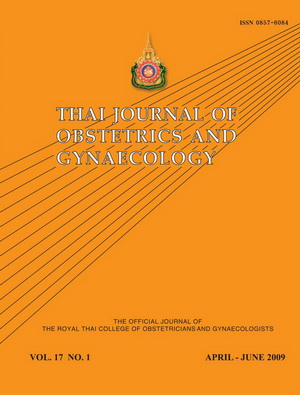Preliminary Study : Comparison of the Efficacy of Progesterone and Nifedipine in Inhibiting Threatened Preterm Labour in Siriraj Hospital
Main Article Content
Abstract
Objective: To compare the efficacy, success rate, maternal and fetal complications of progesterone and nifedipine administration as a tocolytic agent to women with threatened preterm labour.
Study Design : A randomized controlled trial.
Material and methods: During 1st January to 31st May, 2008, a total 40 pregnant women with threatened preterm labour between 28-35 weeks were participated in this study. All women were inhibited contractions randomly with proluton depot 250 mg. intramuscularly weekly or nifedipine 20 mg. orally every 30 minutes for 3 times then maintenance with nifedipine SR 20 mg. every 12 hours until 34 weeks. If neonatal intensive care unit was not available, the inhibition of labour had been prolonged until 36 weeks of gestation. If there was any complication or contraindication with neither proluton depot nor nifedipine, the inhibition method of contractions was changed to be either bricanyl or magnesium sulfate intravenous form.
Results: Forty pregnant women with threatened preterm labour were participated. Eighteen pregnant women were inhibited contractions with proluton depot whilst 22 pregnant women had uterine contraction inhibition with nifedipine. Both groups were not statistically significant in dermographic data, efficacy, mode of delivery and newborn data.
Conclusions: Proluton depot and nifedipine can be used successfully to inhibit contractions in threatened preterm labour. No complication was detected in both groups. Proluton depot seemed to have more efficacy than nifedipine. However, future large study is needed to confirm the efficacy of both drugs to prevent the process of threatened preterm labour to be preterm labour. This can minimize later preterm birth and decrease both perinatal morbidity and mortality.


